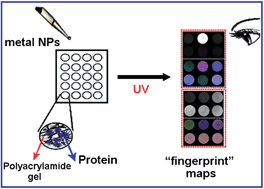Using metal nanoparticles as a visual sensor for the discrimination of proteins†
Abstract
Protein discrimination is increasingly studied because of its roles in biological chemistry. In this study, we introduced a visual sensor using the metal nanoparticles (NPs) of Au, Ag, Cu, Ni and Co to determine the fluorescence (FL) intensity and colour changing patterns to identify ten types of proteins in a polyacrylamide gel. The synthesised NPs have little to no fluorescence, and the addition of proteins immobilised by the gel could differentially enhance the FL intensity and change the FL colour of the NPs, thereby producing FL recognition patterns. Based on the different FL enhancement indices of metal NPs with proteins, linear discriminant analysis (LDA) is applied to differentiate the proteins. By altering the synthesis method of metal NPs, a sensor with different FL patterns for protein discrimination is created. In addition, we have applied this method to detect the protein mixtures after one-dimensional (1-D) polyacrylamide gel electrophoresis (PAGE), and to evaluate the serum samples from patients with liver diseases and thalassemia and from healthy people. This protein discrimination method is rapid, cost-effective and visual, and it has a “turn on” effect for metal NPs, which may be extended to other proteins or more complex bioanalytes.


 Please wait while we load your content...
Please wait while we load your content...